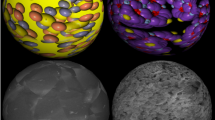Abstract
The leaching of cobalt from four-mixed Co-Cu oxidized ores containing cobalt at levels ranging from 0.5wt% to 34wt% was studied and the results has been reported. Conventional dissolution of these oxidized Co-Cu ores with diluted H2SO4 and SO2 as a reducing agent resulted in a substantial improvement in the solution based recovery of cobalt. UV/visible spectroscopic analysis of the leached solutions indicated that the increased cobalt content in the solution was a result of flushing the acidified cobalt leaching solution with SO2. Furthermore, UV/visible spectroscopy confirmed that as SO2 was flushed into the acidified leaching solution, Co3+ bearing minerals were reduced to the readily soluble Co2+ bearing minerals, and this resulted in the increase of total cobalt in the collected solution. The mechanism of the reduction of Co3+ to Co2+ bearing minerals when SO2 is flushed during the leaching of mixed Co-Cu oxidized ores, including the stability trends of Co3+, Co2+, and Cu2+ complexes, as shown by their UV/visible spectra, are also discussed.
Similar content being viewed by others
References
W. Zhang, P. Singh, and D. Muir, Oxidative precipitation of manganese with SO2/O2 and separation from cobalt and nickel, Hydrometallurgy, 63(2002), p.127.
A.F. Mulaba-Bafubiandi, The effects of process parameters on the acid leachability of cobalt and related impurities from heterogenite ore from Katanga (DRC), [in] Proceeding of SAIMM issue Base Metals Conference: Copper Cobalt Nickel and Zinc Recovery, The South African Institute of Mining and Metallurgy, 2001, p.1.
K.M. Deliens and H. Goethals, Polytypism of heterogenite, Mineral. Mag., 39(1973), p.152.
K. Kongolo, M.D Mwema, A.N. Banza, and E. Gock, Cobalt and zinc recovery from copper sulphate solution by solvent extraction, Miner. Eng., 16(2003), p.1371.
J.A. Golding and Pushparajah, Mass transfer characteristics of cobalt and nickel in di(2-ethylhexyl) phosphoric acid under steady-state extraction conditions, Hydrometallurgy, 14(1985), p.295.
R. Ebrahimi-Kahrizsangi, M.H. Abbasi, and A. Saidi, Molybdenite alkali fusion and leaching: reactions and mechanism, Int. J. Miner. Metall. Mater., 17(2010), No.2, p.127.
H.P. Wang, J. Zhao, W. Liang, Y. Mei, B. Houdeh, and Y. Tian, A new route of ferric ions rejection in a synthetic nickel leach solution, Int. J. Miner. Metall. Mater., 17(2010), No.3, p.257.
N.V. Thakur and S.L. Mishra, Separation of Co, Ni and Cu by solvent extraction using di-(2-ethylhexyl) phosphonic acid, PC 88A, Hydrometallurgy, 48(1998), p.277.
B. Ramachandra Reddy, D. Neela Priya, S. Venkateswara Rao, and P. Radhika, Solvent extraction and separation of Cd(II), Ni(II) and Co(II) from chloride leach liquors of spent Ni-Cd batteries using commercial organo-phosphorus extractants, Hydrometallurgy, 77(2005), p.253.
I. Van de Voorde, L. Pinay, E. Courtjin, and F. Verport, Influence of acetate ions and the role of the diluents on extraction of Cu(II), Ni(II), Co(II), Mg(II) and Fe(II,III) with different types of extractants, Hydrometallurgy, 78(2005), p.92.
A. Knowles and C. Burgess, Practical Absorption Spectroscopy, Vol.3, Chapman and Hall, London, 1984, p.1.
F. Basolo and R. Johnson, Co-ordination Chemistry, Benjamin, New York, 1964, p.152.
B.N. Figgis and J. Lewis, Techniques of Inorganic Chemistry, Vol.4, Interscience, New York, 1965, p.137.
A.B.P. Lever, Inorganic Electronic Spectroscopy, Elsevier, Amsterdam, 1968, p.253.
D. Sutton, Electronic Spectra of Transition Metal Complexes, McGraw-Hill, London, 1968, p.128.
D. Benson, Mechanisms of Inorganic Reactions in Solution, McGraw-Hill, London, 1968, p.158.
Author information
Authors and Affiliations
Corresponding author
Rights and permissions
About this article
Cite this article
Ndalamo, J., Mulaba-Bafubiandi, A.F. & Mamba, B.B. UV/visible spectroscopic analysis of CO3+ and CO2+ during the dissolution of cobalt from mixed Co-Cu oxidized ores. Int J Miner Metall Mater 18, 260–269 (2011). https://doi.org/10.1007/s12613-011-0432-y
Received:
Revised:
Accepted:
Published:
Issue Date:
DOI: https://doi.org/10.1007/s12613-011-0432-y




